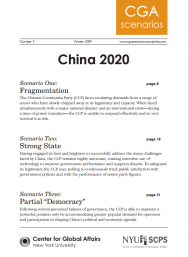
China 2020

Foreward
China’s emergence as a great power in later part of the 20th century has had a tectonic effect upon the conduct of world affairs, driven by the most rapid accumulation of national wealth in human history. As such, its ascendance and possible trajectory is the subject of intense scrutiny by global policymakers, business leaders, and scholars. Future scenarios, particularly when they involve a phenomenon as highly dynamic and complex as China, are easy to criticize, however, because predicting the future is obviously impossible. But the use of scenarios, properly contextualized and bounded, can nonetheless provide penetrating insights about the dynamics at work inside China, identifying key actors, drivers and impediments of change, and possible “wild card” outcomes. In other words, scenario work is largely a heuristic exercise in the best sense of the word, and it can often be a source of enlightenment for serious people in serious jobs that require a highly nuanced perspective on the fragmentary and sometimes contradictory data passing across their desks.
Not surprisingly, the success or failure of scenario development is largely dependent on the quality of the people organizing and participating in the exercise. Michael Oppenheimer and his staff at the Center for Global Affairs have years of experience running these types of meetings, guiding the conversation and extracting the precious metals from the piles of ore. The resulting scenarios reflect both the refined power of the methodology but also the hard work of designing the agenda and inviting the right mix of participants. In the latter respect, they succeeded admirably, bringing together experts from a wide range of disciplines and professions, including economists, journalists, NGO activists, academics, businessmen, and former government practitioners. More important, these experts brought a broad range of personal perspectives to the task, based on years of growing up or living in China, thereby obtaining the necessary but often elusive tactile, instinctive feel for the place and also possessing the introspective self-awareness to interpret and share those impressions. After resisting the initial urges to fight the methodology, the day was filled with spirited debate. The resulting set of scenarios offers three stylized future trajectories for China out to 2020, crafted by some of the most knowledgeable China observers in the field. I would highly recommend them for anyone interested in informed, provocative thinking about the future of China.
James Mulvenon
Defense Group Inc.
January 6th 2010
- Issues:
- Economics, Global and Domestic Governance
- Region:
- Asia
- Country:
- China
- Year Published:
- 2009
- Institutions:
- New York University (NYU), School of Continuing and Professional Studies, NYU Center for Global Affairs

